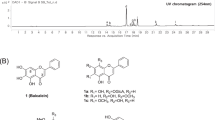Abstract
Tryptase is a serine protease that is released from mast cells during allergic responses. Tryptase inhibitors are being explored as treatments for allergic inflammation in the skin and respiratory system, most notably asthma. Here we report direct tryptase inhibition by natural product compounds. Candidate inhibitors were identified by computational screening of a large (98,000 compounds) virtual library of natural product compounds for tryptase enzymatic site binding. Biochemical assays were used to validate the predicted anti-tryptase activity in vitro, revealing a high (four out of six) success rate for predicting binding using the computational docking model. We further assess tryptase inhibition by a biflavonoid scaffold, whose structure-activity relationship is partially defined by assessing the potency of structurally similar analogs.









Similar content being viewed by others
References
Caughey GH (2016) Mast cell proteases as pharmacological targets. Eur J Pharmacol 778:44–55
Chang HW et al (1994) Inactivation of phospholipase A2 by naturally occurring biflavonoid, ochnaflavone. Biochem Biophys Res Commun 205(1):843–849
Chemicals, I. Indofine Natural Products. 2016; Available from: https://zinc.docking.org/catalogs/indofinenp/.
Collington SJ, Williams TJ, Weller CL (2011) Mechanisms underlying the localisation of mast cells in tissues. Trends Immunol 32(10):478–485
Costanzo MJ et al (2008) Potent, nonpeptide inhibitors of human mast cell tryptase. Synthesis and biological evaluation of novel spirocyclic piperidine amide derivatives. Bioorg Med Chem Lett 18(6):2114–2121
da Silva EZ, Jamur MC, Oliver C (2014) Mast cell function: a new vision of an old cell. J Histochem Cytochem 62(10):698–738
Erin EM et al (2006) Effects of a reversible beta-tryptase and trypsin inhibitor (RWJ-58643) on nasal allergic responses. Clin Exp Allergy 36(4):458–464
Giardina SF et al (2018) A novel, nonpeptidic, orally active bivalent inhibitor of human β-tryptase. Pharmacology 102(5-6):233–243
Hallgren J et al (2001) Heparin antagonists are potent inhibitors of mast cell tryptase. Biochemistry 40(24):7342–7349
Introbioscreen. IBScreen. 2018; Available from: http://zinc.docking.org/catalogs/ibs/.
Irani AA et al (1986) Two types of human mast cells that have distinct neutral protease compositions. Proc Natl Acad Sci U S A 83(12):4464–4468
Khare CP (2007) Indian medicinal plants : an illustrated dictionary. In: Springer reference. Springer, New York x, 812, 1 p., 32 p. of plates
Krystel-Whittemore M, Dileepan KN, Wood JG (2015) Mast Cell: A Multi-Functional Master Cell. Front Immunol 6:620
Li Y et al (2016) Quercetin, inflammation and immunity. Nutrients 8(3):167
Liang G et al (2010) A conformationally constrained inhibitor with an enhanced potency for β-tryptase and stability against semicarbazide-sensitive amine oxidase (SSAO). Bioorg Med Chem Lett 20(22):6721–6724
Liang G et al (2012) Structure-based library design and the discovery of a potent and selective mast cell β-tryptase inhibitor as an oral therapeutic agent. Bioorg Med Chem Lett 22(2):1049–1054
Liedtke, W.B. and S. Heller, TRP ion channel function in sensory transduction and cellular signaling cascades. 2007.
Mori S et al (2003) Nafamostat mesilate is an extremely potent inhibitor of human tryptase. J Pharmacol Sci 92(4):420–423
Ni WW et al (2017) Tryptase inhibitors: a patent review. Expert Opin Ther Pat 27(8):919–928
Ntie-Kang F et al (2013) AfroDb: a select highly potent and diverse natural product library from African medicinal plants. PLoS One 8(10):e78085
Ntie-Kang F et al (2017) NANPDB: A Resource for Natural Products from Northern African Sources. J Nat Prod 80(7):2067–2076
Numerof RP, Simpson PJ, Tanaka R (1997) Tryptase inhibitors: a novel class of anti-inflammatory drugs. Expert Opin Investig Drugs 6(7):811–817
Payne V, Kam PC (2004) Mast cell tryptase: a review of its physiology and clinical significance. Anaesthesia 59(7):695–703
Ru J et al (2014) TCMSP: a database of systems pharmacology for drug discovery from herbal medicines. Aust J Chem 6:13
Sander TaFJavKMaRC (2015) DataWarrior: an open-source program for chemistry aware data visualization and analysis. J Chem Inf Model 55(2):460–473
Selwood T, Elrod KC, Schechter NM (2003) Potent bivalent inhibition of human tryptase-beta by a synthetic inhibitor. Biol Chem 384(12):1605–1611
Specs. Specs Natural Products. 2018; Available from: https://zinc.docking.org/catalogs/specsnp/.
Sutton JC et al (2002) Synthesis and SAR of 4-carboxy-2-azetidinone mechanism-based tryptase inhibitors. Bioorg Med Chem Lett 12(21):3229–3233
Tremaine WJ et al (2002) Treatment of mildly to moderately active ulcerative colitis with a tryptase inhibitor (APC 2059): an open-label pilot study. Aliment Pharmacol Ther 16(3):407–413
Trott O, Olson AJ AutoDock Vina: improving the speed and accuracy of docking with a new scoring function, efficient optimization and multithreading. 2010. J Comput Chem
Author information
Authors and Affiliations
Contributions
NF, MR, and CG conceived and designed research under guidance from MH. JW performed in silico screening. NF, MR, CG, and SF conducted experiments. NF and MR analyzed data, all of which was generated in-house and no paper mill was used. NF, MR, CG, SF, and MH wrote the manuscript. All authors read and approved the manuscript.
Corresponding author
Additional information
Publisher’s note
Springer Nature remains neutral with regard to jurisdictional claims in published maps and institutional affiliations.
Rights and permissions
About this article
Cite this article
Fazio, N.F., Russell, M.H., Flinders, S.M. et al. A natural product biflavonoid scaffold with anti-tryptase activity. Naunyn-Schmiedeberg's Arch Pharmacol 394, 107–115 (2021). https://doi.org/10.1007/s00210-020-01959-2
Received:
Accepted:
Published:
Issue Date:
DOI: https://doi.org/10.1007/s00210-020-01959-2




